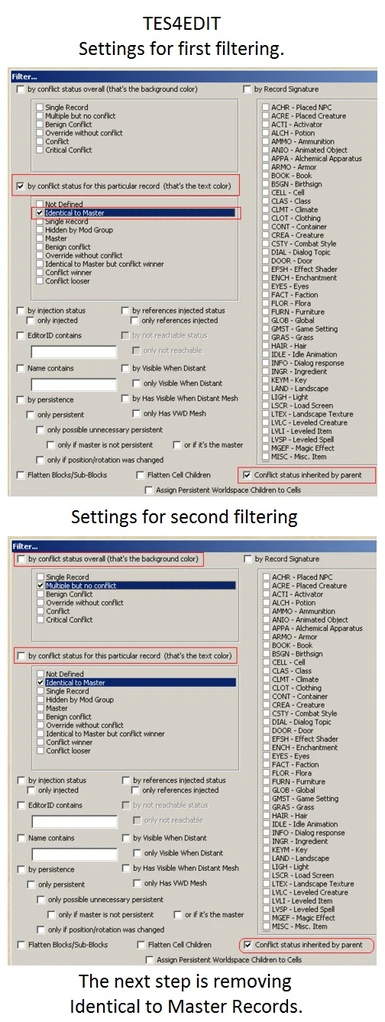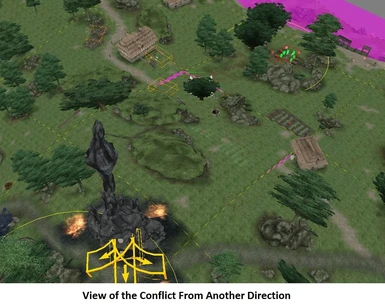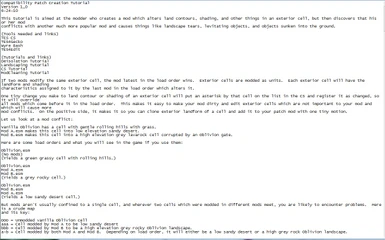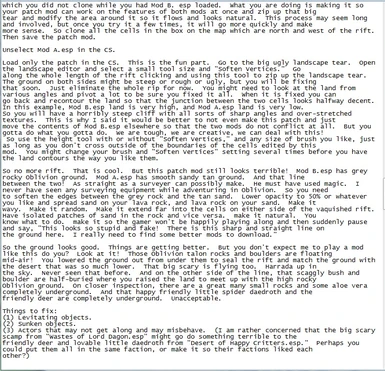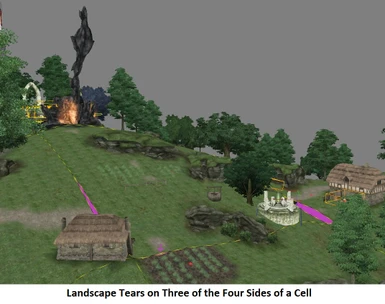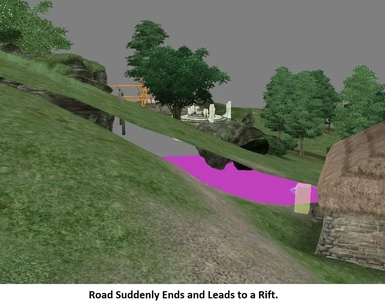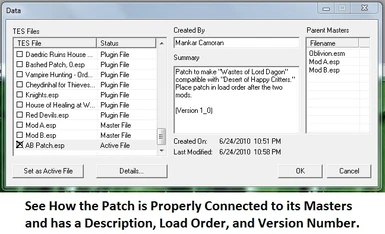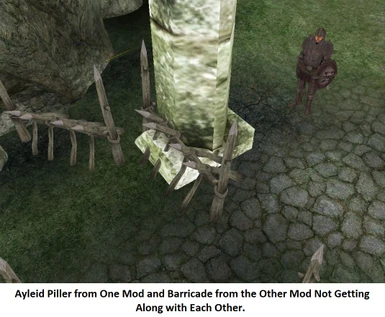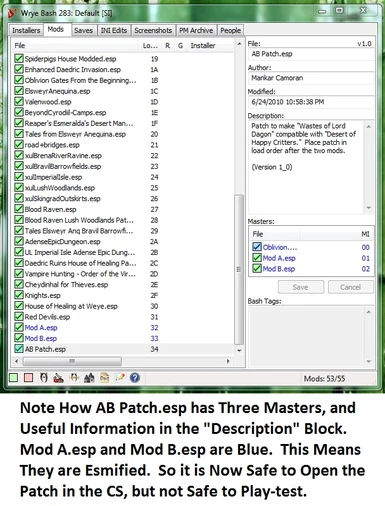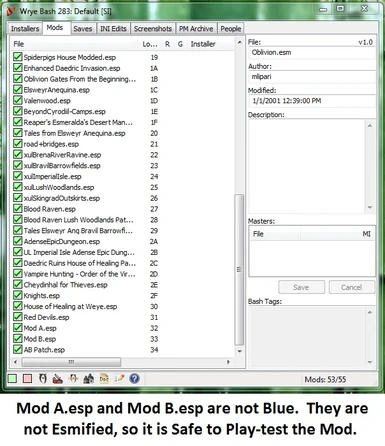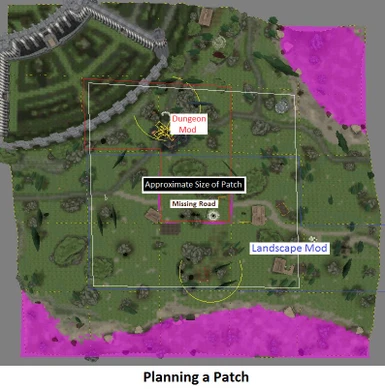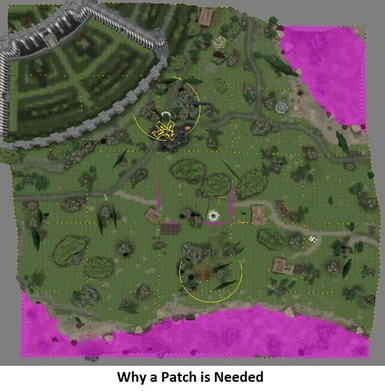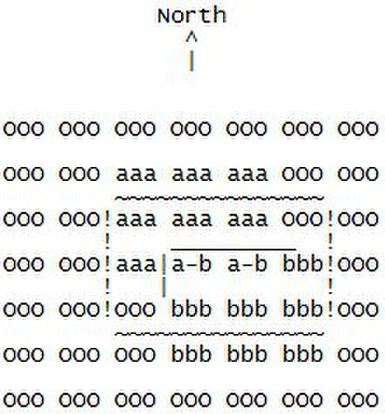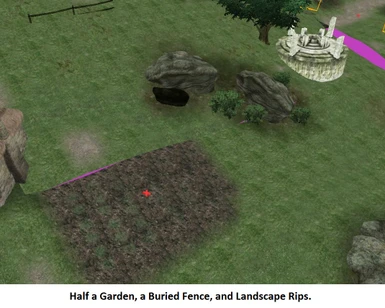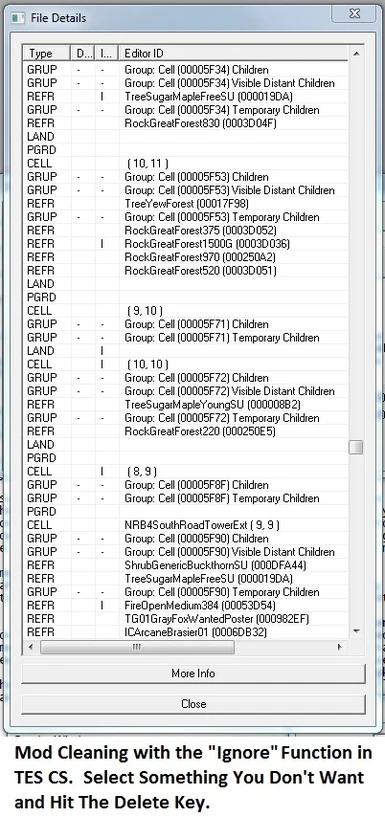About this mod
This tutorial is aimed at the modder who creates a mod which alters land contours, shading, and other things in an exterior cell, but then discovers that his or her mod conflicts with another much more popular mod and causes things like landscape tears, levitating objects, and objects sunken into the ground.
- Permissions and credits
Version 1_0
6-25-10
This tutorial is aimed at the modder who creates a mod which alters land contours, shading, and other things in an exterior cell, but then discovers that his or her mod conflicts with another much more popular mod and causes things like landscape tears, levitating objects, and objects sunken into the ground.
This subject is rather advanced and it is expected that you already have a great number of modding tools and lots of modding knowledge and experience.
Modding software you need to create patches:
TES CS http://cs.elderscrolls.com/constwiki/index.php/TES_Construction_Set
TES4Gecko http://www.tesnexus.com/downloads/file.php?id=8665
Wyre Bash http://tesnexus.com/downloads/file.php?id=22368
TES4Edit http://www.tesnexus.com/downloads/file.php?id=11536
Tutorials that can help bring your knowledge and skill level up to the point where you can create patches:
A beginner's guide, lesson 1 - The Construction Set Primer http://cs.elderscrolls.com/constwiki/index.php/A_beginner%27s_guide%2C_lesson_1_-_The_Construction_Set_Primer
Landscaping Tutorial - Intro and Landscaping http://cs.elderscrolls.com/constwiki/index.php/Intro_and_Landscaping
De-isolation Tutorialhttp://cs.elderscrolls.com/constwiki/index.php/De-Isolation_Tutorial
Mod Cleaning Tutorialhttp://cs.elderscrolls.com/constwiki/index.php/Mod_Cleaning_Tutorial
TES4EditManual http://www.fallout3nexus.com/downloads/file.php?id=8629
Tes4Edit/Mod Cleaning Tutorial with Tes4Edit http://cs.elderscrolls.com/constwiki/index.php/TES4Edit/Mod_cleaning_tutorial_with_TES4Edit
If two mods modify the same exterior cell, the mod latest in the load order wins. Exterior cells are modded as units. Each exterior cell can only have one shape dictated by one mod. Each exterior cell will have the landform and shading characteristics assigned to it by the last mod in the load order which alters it.
One tiny change you make to land contour or shading of an exterior cell will put an asterisk by that cell on the list in the CS and register it as changed, so it will override all mods which come before it in the load order. This makes it easy to make your mod dirty and edit exterior cells which are not important to your mod and which will cause more mod conflicts. On the positive side, it makes it so you can clone the exterior landform of a cell and add it to your patch mod with one tiny motion.
Let us look at a mod conflict:
Vanilla Oblivion has a cell with gentle rolling hills with grass.
Mod A.esm makes this cell into low elevation sandy desert.
Mod B.esm makes this cell into a high elevation grey lava rock cell corrupted by an Oblivion gate.
Here are some load orders and what you will see in the game if you use them:
Oblivion.esm
(No mods)
(Yields a green grassy cell with rolling hills.)
Oblivion.esm
Mod A.esm
Mod B.esm
(Yields a grey rocky cell.)
Oblivion.esm
Mod B.esm
Mod A.esm
(Yields a low sandy desert cell.)
But mods aren't usually confined to a single cell, and wherever two cells which were modded in different mods meet, you are likely to encounter problems. Here is a crude map and its key:
OOO = Unmodded vanilla Oblivion cell
aaa = Cell modded by Mod A to be low sandy desert
bbb = Cell modded by Mod B to be a high elevation grey rocky Oblivion landscape.
a-b = Cell modded by both Mod A and Mod B. Depending on load order, it will either be a low sandy desert or a high grey rocky Oblivion landscape.
North
^
|
OOO OOO OOO OOO OOO OOO OOO
OOO OOO aaa aaa aaa OOO OOO
OOO OOO aaa aaa aaa OOO OOO
OOO OOO aaa a-b a-b bbb OOO
OOO OOO OOO bbb bbb bbb OOO
OOO OOO OOO bbb bbb bbb OOO
OOO OOO OOO OOO OOO OOO OOO
You are going to have a problem in those two cells that say "a-b." There will be a sharp dividing line between the two landforms of the two mods. There will be a huge landscape tear wide enough to ride your horse into, and then you can then plunge to the bottom of the cell and perhaps die. Mod B.esp is higher than vanilla Oblivion and grey and rocky. Mod A.esp is lower than vanilla Oblivion and sandy. Unless you have a high acrobatics skill, you could get hurt walking off the edge of the rocky grey cell and falling down onto the sandy desert cell. Load order could change where your landscape tear is, it could be in two possible positions (see the maps) but it really doesn't matter, because the situation is unacceptable and the gamers are going to complain and probably stop using your mod, because the other mod is awesome and popular and has thousands of downloads, and you are just an upstart modder.
Landscape tear with Mod A.esp loaded last:
North
^
|
OOO OOO OOO OOO OOO OOO OOO
OOO OOO aaa aaa aaa OOO OOO
OOO OOO aaa aaa aaa OOO OOO
OOO OOO aaa a-b a-b|bbb OOO
___________|
OOO OOO OOO bbb bbb bbb OOO
OOO OOO OOO bbb bbb bbb OOO
OOO OOO OOO OOO OOO OOO OOO
Landscape tear with Mod B.esp loaded last:
North
^
|
OOO OOO OOO OOO OOO OOO OOO
OOO OOO aaa aaa aaa OOO OOO
OOO OOO aaa aaa aaa OOO OOO
_________
OOO OOO aaa|a-b a-b bbb OOO
|
OOO OOO OOO bbb bbb bbb OOO
OOO OOO OOO bbb bbb bbb OOO
OOO OOO OOO OOO OOO OOO OOO
Both Mod A.esp and Mod B. esp were designed with vanilla Oblivion as the base, so there will be no landscape tears between cells labeled aaa or bbb adjacent to a cell marked OOO. If you are working with a mod which uses some other mod as a landform base other than vanilla Oblivion, and the mod does not have it as a master, then you will get landscape tears between cells such as aaa or bbb and OOO if landform or land texturing was modded to deviate from vanilla Oblivion, and you do not have the mod loaded and/or the other conflicting mod does not also use it as a base.
My example of a mod conflict is rather extreme, and I would not advise you to make a patch. It would be better to just move your location so that your mod does not conflict with the other vastly more popular mod. But that is not always doable. Your mod might be very elaborate and hard to move. The other mod might be very expansive and cover all possible locations where you might wish to be. The current location might be essential to the story in your mod. So making a patch could be the best thing to do after all.
What you are going to do is make a patch that has one or both of the mods as master, and which is intended to load after the two mods. The reason for making your patch a slave to one or more masters is that you may need to move objects modded by the mod, or have access to meshes or textures in the mod to landscape and decorate the area around the landscape tear you are fixing. It is possible to make a patch with no masters, but then Wrye Bash would not send out warning signals if you use the patch in the wrong position in the load order, and it would be up to the gamer to follow the instructions right. A patch with no masters would be best for fixing a very small landscape tear where that is the only conflict and both mods have landform very close to vanilla Oblivion. Nothing at all like our example.
Load order for our patch:
Oblivion.esm
Mod A.esp
Mod B.esp
AB Patch.esp
OR
Oblivion.esm
Mod B.esp
Mod A.esp
AB Patch.esp
Unless there are other factors to consider, it won't matter which order Mod A.esp and Mod B.esp are loaded in. (A factor might be something like Mod A.esp makes scamps cute and friendly, and Mod B.esp makes scamps really big and tough and scary. If your mod is an Oblivion Wasteland in Cyrodiil, you probably want the second kind of scamp and would want the A, B load order.)
To make your patch, you will open the CS and create an empty new mod and save it with the name AB Patch.esp or whatever is appropriate. It is good to give your files really descriptive names. Suppose that Mod A.esp is called "Desert of Happy Critters.esp" and Mod B.esp is called "Wastes of Lord Dagon.esp." These names are sort of long, but that is better than short meaningless names that get lost in the gamers directories and make him or her frustrated. It would be bad to name your patch something like "patch.esp", "MyPatch.esp.", "88356h.esp" "Joes Cool Patch.esp." Your patch would get lost and perhaps never installed or else installed and then lost in the load order and placed incorrectly. You could then get hate mail about how your stupid patch doesn't work and the angry gamer has removed and deleted Mod B.esp because Mod A.esp is better anyway. So I would recommend putting the abbreviated names of both mods into the patch name. Something like: "Happy Critters Wastes Dagon Patch," "Critters Dagon Patch," or Wastes Dagon Desert Critters Patch. You should also use TES4Gecko to fill in the author and description blanks for your mod so that it can be viewed in places like OBMM, Wrye Bash, and TES CS. You have the space there to give the full names of the two mods you are patching and the required load order. You should also put in the version number of your patch. ("Version 1_0" or "Version 1.0" for example.) So if a gamer complains that your patch is broken, you can find out the version number. Maybe that is the old version and the new version already fixed the problem in question. The version number lets you know what is going on so that you won't waste time chasing phantoms. You should also write a readme file for your patch, just as you do for your mod. The readme file for the patch can be fairly short and might just include a description of what mods the patch is used for, how to install it, and what the load order needs to be. I mention this right now because it is so important, but you will actually want to do it after your patch is made, tested, debugged, and mod-cleaned, shortly before upload. That way you will have all the information available and correct when you write it and won't have to go back and fix things.
So after you have your empty patch mod created. You look at the situation and make a plan of attack:
North
^
|
OOO OOO OOO OOO OOO OOO OOO
OOO OOO aaa aaa aaa OOO OOO
~~~~~~~~~~~~~~~
OOO OOO!aaa aaa aaa OOO!OOO
! _________ !
OOO OOO!aaa|a-b a-b bbb!OOO
!| !
OOO OOO!OOO bbb bbb bbb!OOO
~~~~~~~~~~~~~~~
OOO OOO OOO bbb bbb bbb OOO
OOO OOO OOO OOO OOO OOO OOO
Go on a recon mission. Open up Mod A.esp and Mod B.esp at the same time with your mod, Mod B.esp as the active file so that it will override Mod A.esp in the rendering in the CS window. Press the "B" key to turn on grid lines that mark the boundaries between cells. Write down on a piece of paper, all the cells that your patch needs to clone from your mod, so that it will override Mod A.esp. It will basically be everything south and east of the landscape tear on the map.
Alternately, you might decide that there would be less conflicts to resolve if you did it the other way and loaded the popular mod, Mod A.esp as the active file and your mod just as a reference. But once you decide on which CS load order is best for you, stick with it when writing down which cells landforms you want to keep for your mod and which ones you want to give to the other mod.
Unselect Mod A.esp in the CS. (Or the other mod if you decided to give it priority rather than yours. In that case, flip-flop "A" and "B" wherever you encounter them in the following paragraphs.)
Load your mod (Mod B.esp) and the new empty patch at the same time with the patch being the active file. You need to register changes to all the "a-b" "bbb" and "OOO" cells within the box and on your mod's side of the landscape tear. You are basically cloning and saving everything important about your mod that you wish to override in Mod A.esp. Press the "B" key to turn on grid lines that mark the boundaries between cells. This is very important for this work, to be able to know what is in which cell, and where exactly you are working. To register a change to a cell, go to landscape editor and get set up to adjust land height, land texture, or vertex color (shading.) I think land height and shading are the cleanest and work best. You basically want to make a change no gamer will notice at all, but that the computer will notice. So you might change the height tool to radius 1, and then go to the center part of a cell. Do not go to the edge of a cell! You only want to touch one cell with your tool, because you only want one specific cell to register as a change. You want your patch mod to be clean and have few conflicts, and to be small and not take much memory. Take the height tool, and create a tiny bump or depression. You can then reverse what you did if it is too big of a bump or depression. You are not likely to get it back exactly like it was to start with, but you can get it so that you can't even detect the change with the naked eye. It will still register as a change though, and clone the land contour you want into your patch so the offending Mod A.esp can't trash your hard work. Do this to each of the cells south and east of the landscape tear, (consult the list you wrote during recon.) Remember that you want to touch as few cells as possible to prevent mod conflicts and reduce file size. Beware of diagonals. It may be necessary to clone and modify the cells which are diagonal from two adjacent conflicting cells. When you are done, save your patch mod. (Actually, the CS loves to crash. It hates working with multiple mods open at once, and protests by crashing. You probably ought to save after your first change to make sure it is actually possible to save with this combination of mods open, and then save again after each change you accomplish.)
Unselect Mod B.esp in the CS.
Load the popular mod Mod A.esp and the patch at the same time with the patch being the active file. You need to register changes to all the "a-b" "aaa" and "OOO" cells within the box and on your mod's side of the landscape tear. This could turn into one long boring repetitive paragraph. Basically it is a mirror image of the other paragraph. Everything you did with Mod B.esp needs to be done again with Mod A.esp. You need to clone all the cells in the box on the map which are on the other side of the rift, and which you did not clone while you had Mod B. esp loaded. What you are doing is making it so your patch mod can work on the features of both mods at once, zip up that big tear, and modify the area around it so it flows and looks natural. This process may seem long and involved, but once you try it a few times, it will go more quickly and make more sense. So clone all the cells in the box on the map which are north and west of the rift. Then save the patch mod.
Unselect Mod A.esp in the CS.
Load only the patch in the CS. This is the fun part. Go to the big ugly landscape tear. Open the landscape editor and select a small tool size and "Soften Vertices." Go along the whole length of the rift clicking and using this tool to zip up the landscape tear. The ground on both sides end up steep or rough and ugly, but you will be fixing that soon. Just eliminate the whole rip for now. You might need to look at the land from various angles and pivot a lot to be sure you fixed it all. When it is fixed you can go back and re-contour the land so that the junction between the two cells looks halfway decent. In this example, Mod B.esp land is very high, and Mod A.esp land is very low. So you will have a horribly steep cliff with all sorts of sharp angles and over-stretched textures. This is why I said it would be better to not even make this patch and just move the contents of Mod B.esp elsewhere so that the two mods do not conflict at all. But you gotta do what you gotta do. We are tough, we are creative, we can deal with this! So use the height tool with or without "Soften Vertices," and any size of brush you like, just as long as you don't cross outside of the boundaries of the cells edited by this mod. You might change your brush and the "Soften Vertices" setting several times before you have the land contours the way you like them.
So no more rift. That is cool. But this patch mod still looks terrible! Mod B.esp has grey rocky Oblivion ground. Mod A.esp has smooth sandy tan ground. And that line between the two! As straight as a surveyor can possibly make. He must have used magic. I never have seen any surveying equipment while adventuring in Cyrodiil. So you need to soften the edges between the grey rock and the tan sand. Lower opacity to 50% or whatever you like and spread sand on your lava rock, and lava rock on your sand. Make it wavy. Make it random. Make it extend far into the cells on either side of the vanquished rift. Have isolated patches of sand in the rock and isolated patches of rock in the sand. make it natural. You know what to do. make it so the gamer won't be happily playing along and then suddenly pause and say, "This looks so stupid and fake! There is this sharp and straight line on the ground here. I really need to find some better mods to download."
So the ground looks good. Things are getting better. But you don't expect me to play a mod like this do you? Look at it! Those Oblivion talon rocks and boulders are floating mid-air! You lowered the ground out from under them to seal the rift and match the ground with the desert that was so much lower. That big scary scamp is flying too. Harrada up in the sky. Never seen that before. And on the other side of the line, that scraggly bush and boulder are half-buried where you raised the land to meet up with the high rocky Oblivion ground. On closer inspection, there are a great many small rocks and some aloe vera completely underground. And that happy friendly little daedroth and the friendly deer are completely underground. Unacceptable.
Things to fix:
(1) Levitating objects.
(2) Sunken objects.
(3) Actors that may not get along and may misbehave. (I am rather concerned that the big scary scamp from "Wastes of Lord Dagon.esp" might go do something terrible to the friendly deer and lovable little daedroth from "Desert of Happy Critters.esp." Perhaps you could put them all in the same faction, or make it so their factions liked each other?)
But stop! You can't do anything yet. The things you need to change do not reside in your patch. The things that need to be changed reside in two mods. One of which you have no right to mod and upload. This is why you are making a patch.
Now is the time to use Wrye Bash. Time for enslaving! Time for cruel masters! Time for dominance and submission. Time for me to quit being theatrical and get back to business. If you have not read the tutorial or do not know the material, now might be a good time to read the De-isolation Tutorialhttp://cs.elderscrolls.com/constwiki/index.php/De-Isolation_Tutorial
Working with masters is a big pain, and accidents can happen. You should save your work often, and save it with different names at different times so that you have a variety of saves to revert to if you slip and ruin your mod. (Redoing work stinks.) You must be very careful. If you open your mod in the CS without first esmifying the masters, you have broken it and might not be able to fix it. If you do a play-test, and play Oblivion without first espifying those masters you esmified, the game will behave strangely. (Like the ground might not be there.) If you save, you might be able to ruin your savegame. Pay close attention to what you are doing. Double check the state of the masters to see if they are .esps or virtual .esms (which will still be named Mod A.esp and Mod B.esp even though they are acting as Mos A.esm and Mod B.esm.) look to the blue lettering or lack thereof in Wrye Bash. Look to the list of masters for AB Patch.esp in the CS "Data" screen. Periodically verify that it has Oblivion.esm, Mod A.esp and Mod B.esp as masters. Make those backups!
I get ahead of myself. What you need to do is make it so the patch has Oblivion.esm, Mod A.esp, and Mod B.esp as masters. After getting it set up this way, you will find yourself constantly bit-flipping Mod A.esp and Mod B.esp back and forth between default .esp mode and Wrye Bash .esm mode every time you go to mod and every time you go to play-test. Be very careful. Reread the last paragraph.
So go slave AB Patch.esp to Mod A.esp and Mod B.esp.
This is what you will basically do:
Start Wrye Bash. Right click on the patch. Select "Add Master." Make one mod a master. Repeat. Make the other mod a master. When the mod has the two mods and Oblivion.esm as masters, click the "Save" button in the little box that lists the masters.
So now the patch has masters.
Start Wrye Bash, then right-click on the first conflicting .esp.
Click the option "esmify Self."
Now right-click on the second conflicting .esp and click ".esmify Self."
Open the CS.
Check both of the conflicting mods - they're now up at the top of the list, amongst the .esms.
While an esp is espified, the CS thinks it is an esm, and will allow you to create new .esps which edit the other .esps exactly as if they were .esms. So now you can reposition everything however you want.
Open AB Patch.esp in the CS. The three masters will all automatically open. You can now move talon rocks and boulders and small rocks and actors and whatever you wish. Bring the levitating objects to the ground. Raise the sunken objects to the surface. Move the clipping objects so they are not occupying the same space and looking broken. Move that big boulder that the other mod put in front of your door so that the quest cannot be completed. Get rid of those cheerful desert flowers in your grim Oblivion landscape.
And don't forget the actor conflicts. Move that ragged desert man who complains of being so lonely and of not having seen another human for days away from that large army of adventures getting ready to storm the Oblivion gate. Fix the faction of the big scary scamp so he won't hurt the happy friendly desert deer and daedroth and ragged desert man but will hurt the adventurers. (I don't think the adventurers would hurt the lonely man in the desert, but you might want to check up on that.)
Oh the power! It is so fun modifying mods that you don't have modding rights to. But it is perfectly permissible and considered ethical enough. All you are doing is uploading a patch. Gamers must download the original mod uploaded by the owner, and they can chose to use your patch or not. You have stolen nothing from the original modder.
Important to remember!!!!
Always esmify every .esp which your active .esp is dependent on before launching the CS. Forgetting to do so will break the patch.
Always espify every esmified .esp before using them in-game. Forgetting to do so will make a complete mess in-game of whichever worldspace(s) those .esps touch. Harmless however, as long as you don't save your game.
How many masters do we really need?
In our example we must have it so the patch has two mod masters plus Oblivion.esm as the master which everything always has.
(A) If we were fixing one tiny little tear, maybe we could have no master.
(B) If only the Oblivion talon rocks and boulders were floating, but the other mod was okay, then we would only need Mod B.esp as a master.(In addition to Oblivion.esm which is always a master.) If there are just a few floating or sunken objects, consider raising or lowering the ground to meet them, rather than creating another master with all that it entails.
(c) If we have floating Oblivion rocks and sunken desert rocks and sunken cute friendly creatures, and a looming massacre where the big scary scamp is going to go slay the cute friendly deer and happy little daedroth, then aspects of both mods must be changed and we need both mods to be masters to the patch. We do as little mastering as possible, but as much as we need to.
So now the mod patch is looking pretty good. (If you can suspend disbelief long enough to tolerate this Oblivion wasteland right next to this desert of happy friendly creatures in the middle of the green rolling hills and grasslands of Cyrodiil. But it is a fantasy game after all.)
But something is amiss. We fixed land contour and land texture, but we forgot the shading (vertex color.) That boulder over there that straddles the cell boundary where the landscape tear used to be has a black shadow around its base on one side, but not on the other, the sharp line between darkness and light following the exterior cell boundary. You should go fix the shading around your boulders, trees, and structures. There may also be random shading to darken part of the sand or rock. We want this mod to be Bethesda quality. We want the trolls to have nothing to say. Instead of saying, "yer mod sux cuz theres rox floatun all a round" They will be reduced to saying, "yur mod wood be betur if it had pirates n ebony longswords n ghosties that skreech"
There is also the path-gridding to be seen to. Path-gridding will be inherited from the mod that land contour, texturing, and shading was inherited from. You need to make the paths go out around rocks and trees and structures. They must not go through them. They should not be levitating or sunken. It is said that actors may spawn underground with submerged path-gridding, and I have seen actors who would not garrison their editor locations because there was no path-gridding. Some people don't understand or use path-gridding but it is very important. I just hate having stupid enemies running into rocks and walls. I can stand back and shoot them full of arrows at my leisure. It is so lame. The enemies can't find you, and your companions might stop following you. Easy battles are one thing, but having that gorgeous person you adore so much abandon you! It is just dreadful. Use path-gridding!
One thing you might encounter is daisy chains or cascades or whatever you want to call them. a mod has to have its landform contours meet up with vanilla Oblivion landform contours at all points around the perimeter of the edited cells of the mod. Otherwise there will be landscape tears. Some mods drastically alter the land contours so that none of them match vanilla Oblivion Contours except for the ones on the edges. Some mods like this cover a great number of cells. Look at "aaa" in this example:
North
^
|
OOO OOO OOO OOO OOO OOO OOO OOOOOO OOO
OOO aaa aaa aaa aaa OOO OOO aaa aaa OOO
OOO OOO aaa aaa aaa aaa aaa aaa aaa OOO
OOO aaa aaa a-b a-b a-b aaa aaa OOO OOO
OOO aaa aaa a-b a-b a-b aaa aaa OOO OOO
OOO OOO aaa a-b a-b a-b aaa aaa aaa OOO
OOO OOO aaa aaa aaa aaa aaa aaa OOO OOO
OOO OOO OOO OOO OOO OOO OOO OOO OOO OOO
In the daisy chain or cascade nightmare, if you try to just patch the cells next to your mod, you will fix the landscape tears there, but new landscape tears will appear one cell further away. Go fix those, and they will appear yet again, one more cell further away. It will go on forever until you clone and patch the entire landscape area of the mod, or it moves to an area that is identical in land height to vanilla Oblivion. This means it is good to think hard about the possible effects of what you are doing, and means it it good to play-test the entire perimeter of your patch at a distance of one cell as well as testing the the area where you were expecting the rifts to occur if more prosaic things went wrong.
This makes it so it would not be good to just try to make your base mod fully compatible without using a patch. If you did, you would have to clone and override every cell edited by the large mod. And your mod would have to come after it in the load order. So in the above example, a compatible version of Mod B.esp would have to have 40 modded exterior cells in it. If you made a patch, it would still be large but would only require 25 modded exterior cells. So making a mod fully compatible with no patch might be a good idea if the other person's mod is small or doesn't have much landform that deviates from vanilla, but with a mod like the one in the map above, you would be much better off with a patch.
A fully compatible mod has to do two things perfectly.
(1) Work with the other mod installed.
(2) Work with vanilla Oblivion without the other mod installed.
So a patch has a simpler job. It only has to do one thing:
(1) Work with the other mod installed.
You would never even try to run the patch on vanilla Oblivion, because without its master, it would prevent Oblivion from even starting up.
Some mods adjust water level in exterior cells. If your mod conflicts with a mod that has lakes and rivers, you may suddenly notice that the water is gone in big square patches. Modding actions and mod conflicts can cause this. You can put the correct water level into your patch to fix things. Look at the original mod and see what the water level for the cell is supposed to be. Write it down, and then type that number into the water level box in the proper cell in your patch.
Now you are ready for inspection and play-testing. These steps are very important and often don't receive enough attention. And if you upload a defective patch and find out what you have done, for the love of Azura, do something about it! Don't just leave a junk patch there for innocent victims to download, fix the problem and upload it as patch version 1_1 or whatever number you have reached. Failing that, pull down or hide your defective patch from the public to prevent downloads.
Inspect your work from all angles in the CS. Look for landscape rips, floating objects, sunken objects and intersecting objects like an Oblivion groundspike sticking out of the roof of the hermits's shack. Look from many angles and over a wide area.
When you are done, save and play-test. Be sure to espify your mods in Wrye Bash. Be sure to fix your load order which can get messed up while modding. Turn your grass distance down to 0. This can be done in-game in the options menu. The reason for doing this is so you can easily spot landscape tears that would otherwise hide in the grass. When you are done play-testing that part, it is good to turn the grass back on and look for grass growing up through boulders, paving stones, sidewalks, campfires, benches, and other things that look really stupid with grass growing through them. You may need to replace some grass textures with the corresponding no-grass textures in order to undo bad changes made by one mod to an important area of the other mod. Like one mod might put grass in the middle of a garden or a road in the area important to the other mod.
Nobody is perfect. I expect there will something wrong with the patch. Maybe many things. Write them down. Go fix them. Play-test again. Write down problems again. Go fix them. When you run out of problems to fix after repeated play-testing, then you can get ready to upload. Believe me, it works better to find and fix your own problems in advance rather than to have others point them out to you when you are busy and unmotivated and cannot fix them in a timely fashion.
Mod cleaning is very important. Your patch is designed to solve a problem. That would be very bad if it created a new one. Use TES CS or some other tool to open the list of all the edits you made in the mod. Look for anything that does not need to be there and remove it from the mod. So if your patch out in the wilderness modifies The IC Market district, Silver Claymores, and Jauffre, something is seriously wrong. Remove those accidental or wild edits to prevent some really freaky mod conflicts. And then there are the invisible dirty edits that the CS cannot see, but which can cause a mod conflict and increase file size. The identical to master records. Lets say our mod makes scamps big and scary. But George makes a mod with a suit of armor and no scamps. His mod is dirty. It makes an invisible identical to master edit that makes scamps like vanilla Oblivion. But it is an EDIT. It registers as a change and overrides vanilla Oblivion scamps and all mods that come before it in the load order which edit scamps. If George's mod loads after our mod, we will end up with ordinary boring scamps and be wondering what the heck happened. So although identical to master edits are invisible, they can be quite harmful.
If you don't already know how to do the procedure, read this tutorial and learn how to use TES4Edit to remove identical to master edits:
http://cs.elderscrolls.com/constwiki/index.php/TES4Edit/Mod_cleaning_tutorial_with_TES4Edit
Some gamers are connoisseurs. They are experts with TES4Edit. Although you cleaned your mod in some other utility, you may receive hate mail that says something like, "Your mod is dirty! You have 79 identical to master records out of 289 edits. You really need to learn to use TES4Edit." You have the power to upload better mods and avoid some of the hate mail. Learn TES4Edit.
Here is some advanced advice from an expert for making really clean mods with small file size and reduced chance of conflict, and for dealing with more complex conflicts:
"Once a compatibility patch has been made, it will often contain edits not needed to resolve the conflict, which themselves might cause conflicts with other mods. An example of this would be the corner of a cell, where it meets the corners of three other cells. Let's say that there is a land tear between two cells leading almost to the corner. If you fix the land tear, you'll likely end up with land records from all four cells in your new .esp, even though you only needed the two where the tear existed. With TES4Edit you can easily find and remove the other two land records (and in fact it's possible that the automated cleaning process from the tutorial might remove them for you). This is very useful as it means the patch only contains the land records it needs to contain, so the file size will be less, and there is no chance of introducing new conflicts with other mods in your attempt to resolve the previous conflicts.
It is even possible to only have one of the land records from the tear in your patch. Here is something I always try to do with my patches: in the CS, find the land tear, and if you already have to edit the land height in one cell, but have no reason other than the land tear to edit land height in the other cell, then place the centre of the mouse cursor above the land tear, slightly on the side of the tear which you don't need in the patch. Click and release the mouse button without dragging, and the land tear will close itself automatically, snapping the land edge from the other cell (the one you do need in the patch) to the edge from the cell you clicked into (of course, if the tear is very large, this won't work so well, but with small tears it works wonders). Once you've closed the tear, you can save the .esp, close the CS, open the .esp with TES4Edit, and remove the unwanted land record. The tear will still be repaired! You can do the same with land texture mismatches. For the cell you need to edit anyway, try to retexture to match the textures from the other cell. Don't worry about texturing across the cell border, as you can remove the entire land record with TES4Edit later. You can even repeat over and over (retexture in CS, save, exit, remove in TES4Edit, save, exit, retexture in CS, save, etc.) until you're happy with the result.
For larger tears where doing the above would result in an ugly sharp slope, you can still do what I described, but you'll also need to build up (or down) the slope into a more gradual incline slightly further away from the cell border. This will certainly require repeated trips back and forth from CS to TES4Edit, and takes time, but gives good results in the end.
If I need to move a door, then I will not move it. Instead I will replace it, and disable the original one. As you probably know, persistent objects (such as doors, x-markers, map markers, quest objects, thankfully not NPCs and creatures however, if you move these they really do pay attention and move) once loaded into a player's game, will NOT pay any attention to being repositioned. Their XYZ coordinates get stored into the gamesave, and if the .esp which placed them, or a patch .esp loading after tries to move them, they won't move for that player. So to resolve, simply disable the old door, place a new one where you need it to be, and redo the teleport link to wherever the disabled door used to go.
As for other quest-related objects like x-markers, these are the last things you want to be editing in a patch, but sometimes even these cannot be avoided. It's easy enough with map markers as long as they're not referenced by a quest or script, you simply place a copy wherever you need it, then untick the Marker Data box on the original so that it is no longer treated as a map marker. X-markers which are referenced by AI Packages aren't too big a deal. Place a new x-marker, then update every AI Package to redirect to the new marker instead of the old marker. All these changes will revert back to what they used to be if the player decides to stop using the patch, so no damage will be made to their game.
Potential game-damage comes if you need to edit anything referenced by a script or a quest. This is because you cannot move them (since for those who have already visited the location their gamesave will negate the move), and you cannot simply create new copies as this would require editing the quest record or the script and recompiling it (which might not revert back if the patch gets removed later). So far I've always managed to get around this by writing a new script which checks for whatever conditions trigger the original mod's script to point to the original x-marker, and then making my new script redirect to the new x-marker."
* * * * * *
A brief note on conflict detectors. Some conflict detectors see that the patch is linked to a master and disregard all conflicts between the patch and the master and don't report them. I am not certain that all conflict detectors work this way. We intentionally made our patch so that every single edit in it conflicted with one or the other of its masters. This was on purpose. This was the reason for making the patch. If any gamers report conflicts with the mods the patch is patching, listen politely, and if there is no substance to their reports, you might explain the form and function of a patch to them in short sentences with small words, and tell them that it would not be a patch if it didn't change and fix anything.
I have thrown an awful lot of arcane jargon-laden sentences and paragraphs at you all at once. Hopefully some of them made sense and provided you with clues on how to figure things out on your own. Just as Oblivion is a single player game, it often seems that modding is a solo activity and each modder must re-invent the wheel and start from the ground up with very little aid. Maybe this helped, maybe it didn't, but there is so very little documentation around that the bar is not raised very high. With persistence, you will figure this aspect of modding out, and I look forward to playing some of your mods someday.
FEEDBACK REQUESTED. This tutorial probably doesn't make much sense and you might not be able to understand it. If you find errors in it, missing information that most readers would need, or parts of the tutorial that just aren't clear at all, contact David Brasher on TES Nexus so that it can be fixed and a new version can be uploaded.
Credits:
Technical Advice: Voriens of the Unique Landscapes Project
Data Entry: David Brasher










